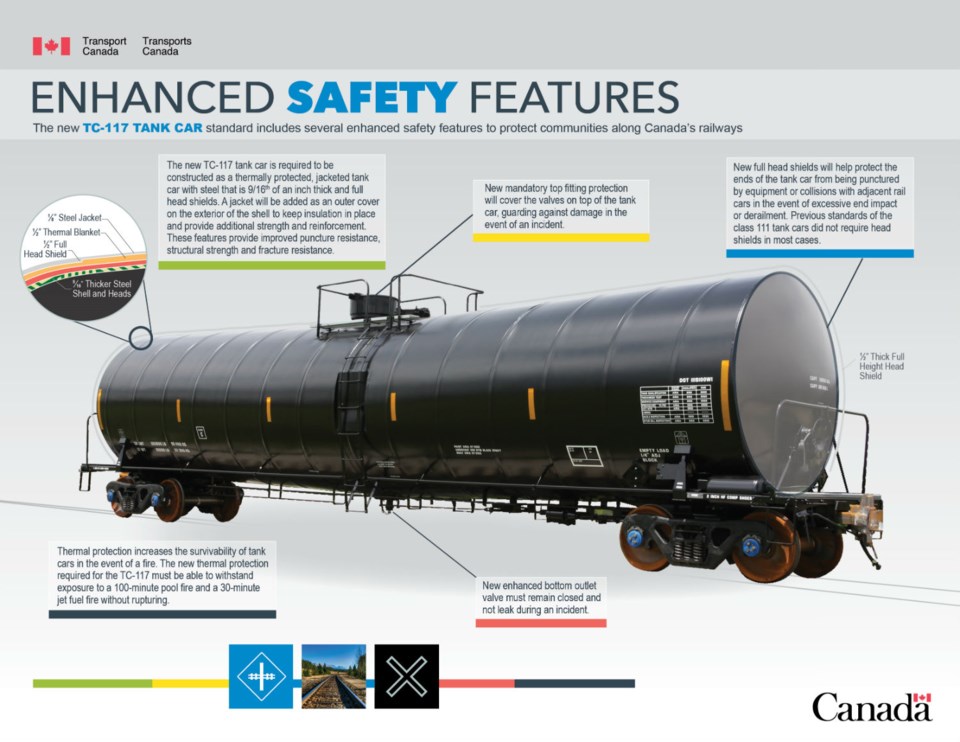Guernsey, Sask. – On Dec. 11, the Transportation Safety Board released an updated statement on its investigation into the Dec. 9 crude-by-rail derailment near Guernsey, Sask.
Under the heading of “What we know,” the statement read, “On Dec.9, 2019, a Canadian Pacific (CP) crude oil unit train 516-398 was proceeding eastward at about 45 mph (miles per hour) on the CP Sutherland Subdivision. The train originated at Rosyth, Alberta, and was destined for Stroud, Oklahoma, USA. The train crew was composed of a locomotive engineer and a conductor. Both were qualified for their positions and fit for duty.”
(Railways operate in the imperial system, using miles as their standard unit of measure.)
Rosyth, Alta, is immediately east of the Hardisty oil terminal, the principle oil hub for Canada. There is a there, operated by Gibson Energy in a joint venture with USD Group. The Gibson website notes it “has the ability to load up to three unit trains per day, moving approximately 180,000 barrels per day.”
On Dec. 3, Canadian Pacific to construct a diluent recovery unit at Hardisty with a 50,000 bpd capacity. Diluent is used to dilute bitumen, which otherwise will not flow in its native state.
Stroud, Okla., is 12 miles (20 kilometres) from Cushing, Okla., the principal oil hub for the United States.
The TSB did not indicate which route the train would have taken to Oklahoma. According to , from Guernsey it could have gone south, to Regina, Moose Jaw and Estevan down to Minneapolis, or it could have continued eastward through Yorkton to Winnipeg, and south to North Dakota. Either way route would have had it eventually on the Soo Line to Minneapolis. CP’s mainline network ends at Kansas City, which would have then required a different rail company to take the train to Stroud.
The origin and destination of this train essentially mirror the origin and ultimate destination of the proposed Keystone XL pipeline, although the terminus for that pipeline would be Steele City, Neb. There it would join the Cushing Extension, which runs from Steele City to Cushing.
The TSB statement continued, “At 0010 Central Standard Time, the train experienced a train-initiated emergency brake application at Mile 48.85, near Guernsey, Sask. Initial site examination determined that the covered hopper car in position two and the following 33 tank cars had derailed. The derailed tank cars consisted of a mix of nine Class 117R and 24 CPC-1232 Class 111 tank cars. There were no injuries reported. The temperature at the time was about −19°C.”
The reference to the “covered hopper car” appears to be a reference to the practice of using a “buffer car,” an empty, non-tanker rail car, between the engines and the oil-carrying cars. This is a typical safety feature in crude-by-rail trains.
The statement said, “The head-end 23 tank cars derailed east of the crossing and came to rest in various positions in a large pile over a distance of approximately 500 feet. About 20 of the 23 tank cars sustained breaches, released product and became engulfed in a large pool fire which burned for approximately 24 hours.
“Preliminary examination of the 23 cars suggests that about 19 of the cars lost their entire loads releasing an estimated 1.5 million litres of product to either the ground or atmosphere. A more precise determination of the tank car damage and the amount of product released will be made as product is recovered and the investigation progresses. No waterways appear to be affected.”
That volume, 1.5 million litres, equates to 9,435 bbl. of oil. However, a typical crude-by-rail car can carry 600 to 700 bbl. each, although they can range from 550 to 725 bbl each. If 19 cars spilled at 600 bbl. each, that equates 11,400 bbl., while cars with a 550 bbl. capacity would carry 10,450 bbl. Pipeline News has inquired about this discrepancy, and the TSB responded Wednesday evening that they would get back to us on this.
The statement noted, “The tail end 10 cars derailed west of the crossing, sustained minimal damage and remained intact with no loss of product.”
The TSB said it has deployed six investigators to the occurrence site. Work on-site is progressing. All 33 tank cars will be examined in order to evaluate tank car performance.
“Mechanical and track components recovered from the derailment will be examined and any components of interest will be sent to the TSB Engineering Laboratory in Ottawa for detailed analysis,” the statement concluded.
Highway 16, which had been closed following the derailment and fire, was reopened mid-afternoon on Dec. 10. The rail line reopened for service that morning.
On Dec. 10, the TSB told Pipeline News a typical investigation for an incident of this magnitude takes 600 days.




